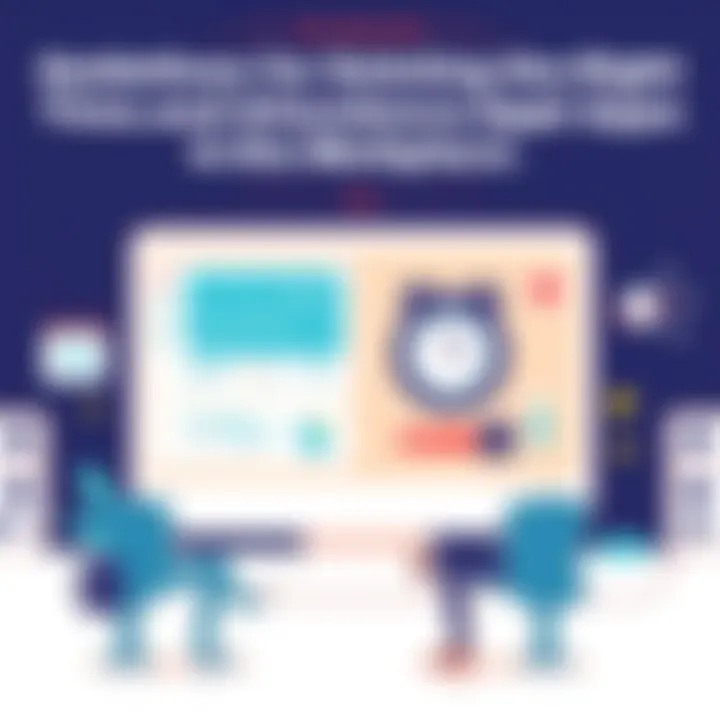Understanding Time and Attendance Apps in the Workplace


Intro
In today's fast-paced business environment, the demand for effective time and attendance solutions has never been more critical. Workers and employers alike are inundated with the challenges that come with tracking time, such as absenteeism, overtime, and compliance with labor laws. That’s where time and attendance apps step in, serving as indispensable tools that not only streamline these processes but also provide deeper insights into workforce dynamics.
These applications are much more than mere clock-in and clock-out tools; they embody a range of functionalities that address various operational needs. For decision-makers, IT professionals, and entrepreneurs, a comprehensive understanding of these applications is paramount. By exploring the core features, benefits, and potential pitfalls, businesses can make informed choices that enhance productivity and efficiency.
As we delve into this topic, we will examine several key aspects, including:
- Core functionalities of time and attendance software
- Benefits that extend beyond mere time tracking
- Strategies for selecting the right solution for your organization
Understanding these nuances equips professionals with the knowledge needed to optimize workforce management. In essence, the right time and attendance app can be the linchpin that holds a company's operational framework together, potentially leading to better decision-making and substantial cost savings.
Preamble to Time and Attendance Apps
In the fast-paced world of business today, the efficient management of time and attendance has moved to the forefront of operational priorities. Time and attendance applications play a pivotal role in tracking employee hours, managing leave, and generating reports, all of which are crucial for ensuring smooth functioning of an organization. With the shift towards more digital solutions, these applications not only enhance productivity but also eliminate numerous manual processes that often lead to errors and miscalculations. As we delve into the details of time and attendance apps, it's essential to recognize their growing importance in maintaining an organized and accountable workforce.
Defining Time and Attendance Applications
Time and attendance applications, at their core, are software solutions designed to help organizations track their employees' working hours and attendance records. These tools provide functionalities such as clock-in and clock-out features, leave requests, and overtime calculations, thus simplifying the management of employee time. Essentially, they offer a digital space where employers can maintain accurate records, ensuring compliance with labor laws and better oversight of staffing needs.
While many companies still rely on manual timekeeping methods, time and attendance apps provide a level of accuracy and efficiency that is hard to overlook.
In this digital age, the need for such tools cannot be understated; they automate tedious tasks and significantly reduce the likelihood of human error. For instance, rather than relying on paper forms or spreadsheets, businesses can implement apps that allow employees to log their hours from their smartphones, facilitating a more streamlined approach. This shift to technology also allows for real-time monitoring and reporting, providing insights that were previously cumbersome to analyze.
Historical Context and Evolution
The origins of time and attendance tracking can be traced back to simple manual methods, such as punch clocks and handwritten logs. In the past, employers had to devote considerable time to collecting and processing this information, which often resulted in discrepancies and disputes. These antiquated systems provided limited visibility into employee productivity and often led to inefficiencies.
As technology advanced, the introduction of computerized systems began to change the landscape. This transformation accelerated with the rise of the internet and cloud computing, allowing for the development of sophisticated applications that catered to the evolving needs of businesses. The evolution has not stopped; with the advent of mobile technology, many time and attendance solutions now offer applications that are accessible on-the-go, making it easier for employees and management alike.
Today's applications are built with scalability and flexibility in mind, accommodating a range of business sizes and integrating with other systems, such as payroll and HR management. This evolution reflects a growing understanding of the importance of workforce management and the need for tools that not only keep track of hours worked but also support overall business productivity and employee satisfaction.
Key Features of Time and Attendance Software
Time and attendance software has become an indispensable part of modern business operations, streamlining processes and enhancing overall productivity. The features available in these apps not only ease the tasks of HR departments but also empower employees. Understanding these key functionalities is pivotal for decision-makers who seek to implement a solution that caters to their unique business needs.
Employee Time Tracking
A standout feature of time and attendance applications is employee time tracking. This functionality allows businesses to maintain accurate records of when employees clock in and out. Gone are the days of relying on manual time cards or spreadsheets that often lead to errors and discrepancies.
With automated time tracking, businesses reduce the risk of time theft and ensure compliance with labor laws. Employees can clock in directly from their mobile devices or a web browser, which offers flexibility for those working remotely or in the field. Moreover, many systems allow workers to categorize their hours by project or task, enabling deeper analysis of time allocation and productivity.
Leave Management
Leave management is another crucial element of time and attendance applications. These tools simplify the process of tracking vacation days, sick leave, and personal time off. Employees can send leave requests digitally, and supervisors can review and approve them without the need for endless back-and-forth emails.
This system ensures transparent record-keeping, minimizing the chances of under or over-allocating leave. Furthermore, real-time visibility into who is out of the office helps managers plan workloads more effectively, ensuring business continuity.
Real-Time Reporting
Real-time reporting is an essential feature, allowing managers to generate reports on time usage, attendance patterns, and labor costs instantly. These insights provide a clear overview of employee performance and identify areas for improvement.
For instance, if a particular department consistently reports late arrivals, managers can address this issue directly. Such reporting capabilities also facilitate strategic planning when assessing resource allocation and overtime requirements.
"Real-time insights from attendance apps empower managers to make informed decisions, ultimately enhancing operational efficiency."
Integration with Payroll Systems
Finally, integration with payroll systems is a vital feature that enhances the functionality of time and attendance software. By linking attendance records directly to payroll systems, businesses can ensure that employees are paid accurately for the hours they have worked.


This integration minimizes the risk of payroll errors, preventing potential disputes and dissatisfaction among employees. Moreover, it streamlines the payroll process, saving time and reducing the administrative burden on HR departments. In an environment where accuracy and efficiency are paramount, this feature stands out as a game-changer for businesses of all sizes.
Advantages of Implementing Time and Attendance Apps
In today’s competitive business landscape, the need for precise time management can’t be overstated. Time and Attendance Apps provide multiple advantages that can significantly enhance an organization's operations. Understanding these benefits can help decision-makers choose the right solutions that align with their specific goals and objectives.
Enhanced Accuracy in Time Tracking
The accuracy provided by time and attendance applications is a game-changer. Unlike traditional methods, which often rely on manual entries or spreadsheets, these systems automate the time-tracking process. This reduces the possibility of human error and ensures that employees are billed for the actual time worked. Moreover, many applications offer features like geolocation tracking, which mitigates the risk of buddy punching – a scenario where one employee clocks in for another. Businesses can gain significant insights into labor costs by collecting this accurate data, which can be instrumental when forecasting budgets.
"Accurate time data can lead to smarter decisions, whether it’s optimizing labor costs or allocating resources more effectively."
Cost Savings for Businesses
Implementing an effective time and attendance management application can also lead to substantial cost savings. Companies often overlook the hidden expenses related to time-tracking inaccuracies. These can include paying overtime that isn’t warranted or losing out on billable hours because of poor tracking practices. By streamlining this process, organizations can significantly reduce payroll errors and enhance operational efficiency. With features like automated alerts for overtime, managers can keep expenditures in check and avoid costly surprises at the end of pay periods. This leads to better financial planning and resource allocation.
Improved Employee Accountability
When employees know their time is being tracked accurately, it leads to heightened accountability. Time and attendance applications often come with reporting features that allow employees to see their own work hours, breaks, and absences in real time. This transparency builds trust and encourages individuals to be more responsible with their time. Furthermore, managers can utilize these tools to reward punctuality and adherence to schedules, fostering a culture of accountability across the team. When employees feel that their contributions are recognized, it can improve morale and overall productivity in the workplace.
In summary, as businesses increasingly look to optimize their operations, integrating time and attendance apps not only addresses common inefficiencies but also enhances overall accountability and cost management. Evaluating these advantages can lead to better decisions concerning workforce management and resource allocation.
Challenges and Considerations
When implementing time and attendance applications in the workplace, organizations confront a myriad of challenges and considerations. Understanding these obstacles is crucial for effective integration and maximizing the benefits of these tools. Each challenge can significantly influence the app’s acceptance and efficacy, making it essential to address them thoughtfully.
Privacy and Data Security Concerns
At the top of the list of concerns regarding time and attendance apps is the issue of privacy and data security. With sensitive personal information at stake, organizations can’t afford to take these risks lightly. Data breaches can lead to severe reputational damage and financial loss. According to a report from the Privacy Rights Clearinghouse, the ramifications of inadequate data protection can resonate for years.
- Sensitive Information: Employee data often includes not just names and addresses, but potentially Social Security numbers and financial information as well. If not adequately protected, this data is at risk.
- Trust Issues: If staff feel their privacy is compromised, it can erode trust within the company ecosystem. Implementing robust encryption and adhering to standards like GDPR for employees in the EU can help build this trust.
- Mitigation Strategies: It’s prudent to consider a tool that offers end-to-end encryption and follows best practices in data management. Regular audits of the app's security features should not be overlooked.
"The most important aspect of any technology implementation is the trust it fosters—without it, even the best app is doomed."
Resistance to Change
Change is hard, especially in established workplaces with ingrained habits. Resistance to new methods of time and attendance tracking can undermine the goals of implementation. Employees often have a preference for tried-and-tested methods—like paper timesheets or punch clocks. Recognizing this hesitance is essential for smooth transitions.
- Cultural Barriers: Some teams may view new technology as a threat to job security rather than a tool for enhancement. It’s important to communicate how these changes will empower them instead.
- Training and Support: Offering robust training sessions can alleviate fears around new tools. A knowledgeable staff is more likely to embrace and utilize new technology effectively.
- Involving Employees: Involve employees from the outset in discussions about the selection and implementation process. When they feel heard, they may be more likely to support the change.
System Integration Issues
One cannot overstate the importance of seamless integration when it comes to time and attendance apps. A tool that functions well on its own but fails to communicate with existing systems can prove more harmful than beneficial. Therefore, assessing integration capabilities should be a priority in the selection process.
- Compatibility: It's crucial for any new application to be compatible with other tools already in the organization. Lack of compatibility may mean manual data transfers which introduce room for error.
- API Capabilities: Seek solutions that come with strong Application Programming Interfaces (APIs) so that they can easily connect with payroll, HR management systems, and other relevant software.
- Vendor Support: Consider the level of support offered by the provider during the integration process. Are they available to troubleshoot issues as they arise? A solid vendor can make all the difference in a smooth adoption of the system.
The thoughtful consideration of these challenges will serve to set up organizations for success when deploying time and attendance applications. Attention to these areas not only secures compliance and enhances employee morale but also ensures that the investment yields the desired return in efficiency.
Factors to Evaluate When Choosing a Time and Attendance App
Selecting a time and attendance app is not merely a checkbox exercise in modern workplace management; it is crucial for both operational efficiency and employee satisfaction. As businesses navigate the complexities of workforce management, the importance of carefully evaluating these apps cannot be overstated. Employers must consider a multitude of elements that can significantly impact their organization’s productivity and accuracy in timekeeping. Understanding these factors not only aids decision-makers in selecting appropriate solutions but also ensures the longevity and relevance of the tools chosen.
User-Friendliness
When it comes to time and attendance apps, user-friendliness stands at the forefront. A tool that is cumbersome to navigate can lead to frustration, not just for administrators but for employees too. If the interface is complex, training staff can become a time-consuming chore, and adoption can plummet.
- Intuitive Design: Look for solutions with intuitive layouts that allow employees to clock in and out with minimal hassle. Is there a need for excessive clicks? Does it require a steep learning curve? The goal should be to keep things as simple as pie.
- Mobile Accessibility: In today’s remote working environments, mobile access can be a game-changer. A well-designed app should work seamlessly on smartphones and tablets, providing employees the freedom to track their time from anywhere.
Customization Options


Every business has unique needs, which brings customization options into play. A one-size-fits-all approach often doesn't cut it and can lead to wasted features that are never used.
- Tailored Features: Assess how much you can tailor the app to meet your specific requirements. Can you add custom fields for tracking specific metrics important to your work culture? The ability to modify reports or notifications according to the company's workflow can provide significant advantages.
- User Roles and Permissions: It is vital to set different roles within the software. Determine how easy it is to control what information individuals can access. You don’t want every employee to have the same level of access as HR.
Scalability
As companies grow, their operational demands often shift. Scalability is a crucial factor when choosing a time and attendance app because what works for ten employees may not suit two hundred.
- Growth Potential: Consider whether the app can accommodate a growing workforce or increasing complexity in work schedules. The last thing one wants to face is finding out that the chosen system can't handle new hires without significant upheaval.
- Feature Upgrades: Additionally, inquire about how easily new features are integrated as the app evolves. Organizations should look for a system that enhances usability rather than complicates it as they scale.
Customer Support Services
Even the most elegantly designed app can present challenges, making customer support services a critical element to gauge.
- Availability: Look for platforms that offer robust customer support options. Is assistance available round-the-clock? Can users reach out via chat, email, or phone?
- Self-Help Resources: An extensive help center with guides and FAQs can be invaluable. A knowledge base may ease the troubles faced by users, allowing them to resolve issues independently.
“An educated customer is an empowered customer; having resources at their fingertips makes all the difference.”
Navigating the selection process of a time and attendance solution requires a discerning eye. By focusing on user-friendliness, customization options, scalability, and customer support services, organizations will better position themselves to choose an app that meets both current and future needs. The appropriate tools will not only simplify the process of time and attendance management but can also transform how an organization operates.
Industry-Specific Applications of Time and Attendance Solutions
Time and attendance solutions are more than just tools for tracking hours; they serve as vital components tailored to various industries, each with unique needs and challenges. In an age where efficiency and adaptability hold the keys to success, understanding the specific applications of these systems in diverse sectors can offer businesses a competitive edge. This section will peel back the layers reveals the nuances of time management in selected industries: healthcare, retail, and manufacturing.
Healthcare Sector
In the healthcare industry, time and attendance solutions are not merely conveniences—they’re necessities. Staff in hospitals and clinics often work varied shifts, including nights and weekends. Accurate time tracking is crucial for ensuring staff compliance with labor laws while maintaining quality patient care.
Key benefits of these systems in healthcare include:
- Compliance Management: Ensuring staff adhere to regulations regarding working hours and rest periods.
- Scheduling Flexibility: Streamlining shift assignments and accommodating sudden changes in staffing needs, crucial in emergencies.
- Enhanced Reporting: Providing real-time insights into labor costs, overtime, and employee attendance patterns, assisting managers in making informed decisions.
Given the sensitive nature of healthcare data, security features in these applications are paramount. Solutions that encrypt personal information and maintain compliance with regulations like HIPAA are non-negotiable.
Retail Industry
Time and attendance solutions in retail face the challenge of high turnover rates and dynamic scheduling needs. In this environment, every minute matters; having the right employees on the floor at peak hours is essential.
Benefits of implementing these systems in retail include:
- Optimized Labor Costs: Accurate tracking of employee hours helps prevent overstaffing, saving costs.
- Increased Sales Potential: With streamlined scheduling, businesses can have more staff present during busy periods, ultimately enhancing customer satisfaction and sales.
- Improved Engagement: When employees feel their time is respected with accurate tracking and flexible scheduling, morale improves, contributing to better customer interactions.
Moreover, integration with point-of-sale systems ensures consistency between attendance data and sales performance metrics. This offers retailers a holistic view to strategize shifts and staffing.
Manufacturing Environments
In manufacturing, time and attendance management is as critical as the assembly line itself. Ensuring that employees are clocked in on time increases productivity and safety compliance. This sector’s unique rhythms demand precise tracking systems that account for various roles, overtime, and equipment handling.
Notable applications of time and attendance solutions in manufacturing include:
- Workforce Optimization: Tracking labor hours accurately helps in matching labor to demand, reducing waste and enhancing production efficiency.
- Safety Compliance Reports: By logging time spent on the floor, businesses can analyze issues leading to safety violations and adjust procedures accordingly.
- Integration with Project Management: Gathering time data and linking it with production statistics allows for better forecasting and resource management.
"Efficiency is doing better what is already being done." - Peter Drucker
Through this lens, leaders in healthcare, retail, and manufacturing can see time and attendance solutions not just as an administrative tool but as a strategic asset.
Future Trends in Time and Attendance Management
As the workplace evolves, so too do the tools that companies utilize for managing their workforce. Time and attendance applications have rapidly progressed, integrating advanced technologies and methodologies to meet the needs of both employers and employees. Understanding these future trends is crucial, as they not only shape how companies operate but also enhance overall productivity and employee satisfaction.


Remote Work and Time Tracking
The shift towards remote work has dramatically changed how time tracking is perceived and executed within organizations. With many employees working from various locations, traditional clock-in and clock-out practices have become outdated. Modern time and attendance apps now offer solutions tailored specifically for a remote workforce.
- Mobile Accessibility: Employees can log their hours directly from their smartphones, providing flexibility and accuracy. This means no more pesky missed punches or forgetting to clock in altogether.
- Geolocation Features: Some apps incorporate geofencing technology that allows employers to monitor when remote employees log in from their designated work locations. This adds a layer of accountability without being intrusive.
- Integration with Collaboration Tools: Time tracking apps now often sync seamlessly with popular platforms like Slack or Microsoft Teams. This integration not only streamlines the user experience but also allows for automatic status updates based on active work hours.
The benefits are clear: organizations gain a comprehensive view of employee productivity, while remote workers enjoy a sense of autonomy. However, this transition requires companies to adjust their approaches to trust and accountability.
Artificial Intelligence Integration
Going beyond basic time tracking, the future also points towards a greater incorporation of artificial intelligence in attendance management systems. AI can analyze vast amounts of data swiftly and help organizations in numerous ways:
- Predictive Analytics: By studying trends and patterns, AI can predict employee attendance behavior, helping HR departments plan staffing needs more effectively.
- Automated Reporting: Time-consuming manual reporting can be a thing of the past. AI-integrated systems can generate reports automatically, providing insights without the headache of manual input.
- Enhanced Employee Engagement: AI can offer personalized feedback to employees about their time habits and productivity. This can encourage them to manage their time more effectively and even help identify areas where they might be struggling.
Nevertheless, reliance on AI comes with considerations around data privacy and ethical use of technology. Organizations must navigate these challenges carefully to ensure trust remains intact among their workforce.
"The future of work is not remote or in-office; it's hybrid. And the tools we use must adapt just as quickly as we do."
Evaluating Popular Time and Attendance Apps
As businesses increasingly rely on technology to manage their workforce, understanding popular time and attendance apps becomes crucial. The importance of this evaluation lies in recognizing how these tools can enhance efficiency, mitigate errors, and streamline operations. Decision-makers are tasked with selecting the right app that not only meets their current needs but also grows with their organization. Evaluating these tools includes considering their features, adaptability, and user feedback. By understanding the strengths and weaknesses of various solutions, organizations can make informed decisions that lead to improved productivity and accountability.
Comparison of Leading Solutions
When looking at the plethora of time and attendance apps, a direct comparison reveals significant differences that can make one solution more suitable than another. Key factors to consider:
- Functionality: Some apps focus on simple time tracking, while others offer comprehensive features like payroll integration, scheduling, and analytics. For instance, apps like Toggl are great for project-based tracking, whereas Deputy excels in employee scheduling combined with attendance tracking.
- User Interface: Accessibility can vary. An intuitive design can enhance user experience. Clockify is praised for its clean interface and ease of use, making it favorable for teams that value a straightforward approach.
- Pricing: Cost structures can differ vastly. Some apps, like Time Doctor, operate on a subscription-based model, while others may offer a one-time purchase, such as ActiTIME. Understanding your budget and what features are essential can aid in choosing the right solution.
- Integration Capabilities: Consider the compatibility with existing systems. Various apps boast integrations with platforms like QuickBooks or Slack, which can significantly ease the workload of HR departments.
In this rapidly evolving landscape, the constant shifts in technology necessitate regular evaluations of these tools. The right app should not only meet current requirements but should also be flexible enough to adapt to future needs.
User Reviews and Ratings
User reviews and ratings serve as a window into the real-world efficacy of time and attendance apps. They can provide insights that might not be evident from marketing material alone. Benefits of consulting user feedback include:
- Authenticity: Real user experiences often highlight specific strengths and weaknesses. For example, reviews for Kimble often mention its robust reporting features, benefiting project management, whereas feedback for When I Work indicates easy onboarding.
- Performance Insights: Users often share their insights regarding app performance, allowing potential buyers to grasp how the application functions over time.
- Support Quality: Customer service can make or break user experience. Feedback reveals how responsive and helpful the support teams are. Platforms like Deputy frequently get positive marks for their customer service.
An evaluation of reviews could help in steering clear of applications that may promise the world but underdeliver in practice. While the star ratings provide a snapshot, delving deeper into the reviews can unveil nuanced views that might just be the tipping point towards making a decision. Always consider checking platforms such as G2 and Capterra for in-depth user reports and aggregated scores.
"A good time and attendance app is not just about the features it offers but how those features translate into real workplace improvements and employee satisfaction."
The careful evaluation of these popular apps helps organizations pinpoint not just the right tool but also the alignment of the tool with their distinct needs, ultimately leading to smoother workforce management.
Closure
As we draw the curtain on this comprehensive review of time and attendance apps, the importance of these tools in modern workplaces cannot be overstated. In today's fast-paced business environment, where every minute counts and efficiency is vital, these applications serve as a backbone for effective time management. They not only help in tackling the age-old challenges of attendance tracking but also play a significant role in shaping a company’s financial health and employee morale.
Recap of Key Points
To summarize, the critical features of time and attendance apps include:
- Employee Time Tracking: This ensures accurate logs of when employees clock in and out, providing reliability in payroll processes.
- Leave Management: Streamlined handling of vacation and sick leaves offers better transparency and planning for both employees and management.
- Real-Time Reporting: Instant data access assists in quick decision-making and analysis of workforce productivity.
- Integration with Payroll Systems: Compatibility with various payroll solutions simplifies finances and reduces errors.
Furthermore, the advantages like enhanced accuracy, cost savings, and improved accountability highlight why organizations are increasingly adopting these applications. Of course, challenges such as privacy concerns and system integration can’t be overlooked but can be managed with careful planning and execution.
Final Recommendations for Advisors
For industry advisors navigating the landscape of time and attendance solutions, consider the following recommendations:
- Evaluate user-friendliness: Ensure that the application is intuitive and reduces the learning curve for employees.
- Check customization options: Every business is unique; the flexibility of the software to adjust to specific workflows can make a significant difference.
- Assess scalability: Choose apps that grow alongside your business needs, so you don't outgrow the solution too quickly.
- Prioritize customer support: Responsive support helps resolve issues quickly, ensuring minimal disruption to operations.
By focusing on these elements, advisors can make informed suggestions that lead to improved productivity and streamlined management within organizations. The ever-evolving nature of time and attendance solutions means staying ahead of trends, which ultimately aids businesses in cultivating a more responsible and engaged workforce.
"In the realm of time management, technology is the method to finally keep us on track, both literally and figuratively."
For further insights, resources like Wikipedia, Britannica, and discussions on Reddit can be invaluable for understanding current trends and implementations in time and attendance technology.







